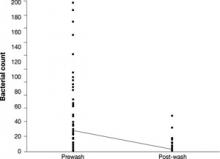Types of bacteria. The TABLE gives the breakdown and frequency of the various types of bacteria that we identified on the stethoscopes. Many were of low pathogenic potential, such as coagulase-negative staph species, which would not cause disease in healthy individuals. However, in hospitalized or immunocompromised patients, they could well induce illness. There were also several clearly pathogenic bacterial isolates, including 3 MRSA colonies (each on a different stethoscope), as well as Pseudomonas and Klebsiella. All of these isolates were killed by scrubbing with foam.
Considering only the MRSA colonies, the number needed to treat is 31 (95% CI, 18-89), indicating that for approximately every 31 hand- and stethoscope-washings with the alcohol-based foam, 1 MRSA colony could potentially be eliminated from a stethoscope head.
FIGURE
Bacterial counts: Prewash and post-wash
The line connects the mean values.
TABLE
What we found on the stethoscopes
| BACTERIA | TOTAL NUMBER OF ISOLATES |
|---|---|
| Coagulase-negative Staphylococcus | 100 |
| Bacillus | 51 |
| Micrococcus | 24 |
| Nonfermenting gram-negative bacteria | 17 |
| MRSA | 3 |
| Coagulase-positive Staphylococcus (non-MRSA) | 2 |
| Lactobacillus | 2 |
| Pseudomonas | 2 |
| Acinetobacter | 1 |
| Enterobacter | 1 |
| Klebsiella | 1 |
| Streptococcus | 1 |
| Zygomycetes | 1 |
| MRSA, methicillin-resistant Staphylococcus aureus. | |
Discussion
The findings of this study suggest that the use of alcohol-based hand foam to simultaneously sterilize the hands and a stethoscope head significantly reduces the number of bacterial colonies, including MRSA. The quantifiable risk of clinical infection with MRSA in patients through brief contact with a contaminated fomite such as a stethoscope is unknown. However, the transmission of the bacteria itself from contaminated surfaces and hands through brief contacts has been well established.11,12
A new standard for cleaning stethoscopes?
Swiping stethoscopes with alcohol pads is currently the gold standard for cleaning these instruments, but physicians do not consistently use alcohol pads for this purpose. Moreover, the pads must be purchased and available for use, require an extra step, and produce waste that must be disposed of—and clinicians still have to cleanse their hands, often using alcohol-based hand foam. Using the foam to cleanse the stethoscope while cleaning hands requires no added cost or additional time, and may reduce or prevent serious nosocomial and community-based infections.
Limitations of the study
One limitation of this study was the lack of control of the washing procedure. But because our goal was to see how the technique fared in actual use among all participants, uniform technique was not required. Knowing they were in a study may have altered the way the participants washed their hands and stethoscopes. If this were true, however, we would expect a much larger proportion of the total variation to be due to differences among clinicians than the 5% that was found.
This technique does not eliminate all bacteria—for instance, sporulating organisms such as Clostridium difficile are not killed by alcohol products.18 Yet friction alone has been found to reduce the number of these pathogens (A.S., unpublished data, 2007).
This study utilized alcohol-based hand foam because it was available at the study institution, so we cannot make any claims for nonalcohol-based products. It does appear, however, that alcohol-based foam may not be susceptible to bacterial resistance, as had previously been found in triclosan-containing products.19
It is not known whether the alcohol-based foam will damage stethoscope diaphragms. Previous studies have suggested that alcohol pads do cause damage to the rubber components of stethoscopes,16 but the foam studied here, like most similar products, contains emollients that may or may not have a protective effect. Another study would be necessary to fully assess this question.
While it is impossible to destroy all bacteria or eliminate all infections by simultaneous hand and stethoscope cleansing, many infections could potentially be prevented with this simple component of a comprehensive infection control program. Alcohol-based hand foam is already in use for hand cleansing between patients in many inpatient and outpatient settings, and this procedure requires no added cost and no additional time. Further research is necessary to determine whether the reduction of bacterial growth also corresponds to a reduction in clinically related disease. The results of this study provide evidence that hand foam, when used to simultaneously sterilize the hands and stethoscope, can significantly reduce the number of bacterial colonies on stethoscopes.
CORRESPONDENCE
Maryellen A. Schroeder, MD, MPH, UPMC St. Margaret, 815 Freeport Road, Pittsburgh, PA 15201; schroederma@upmc.edu


